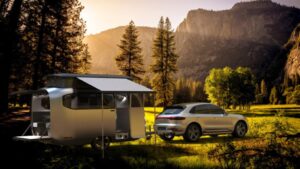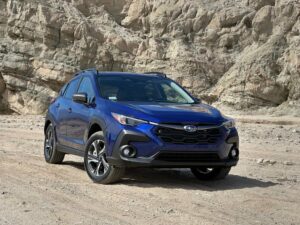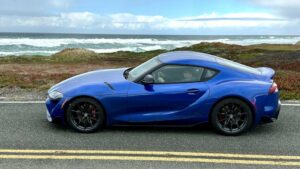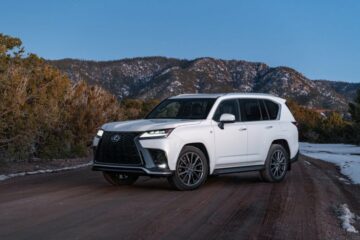Mention the Pacific Northwest and people think of Starbucks coffee, fresh seafood, and maybe Voodoo Doughnuts.
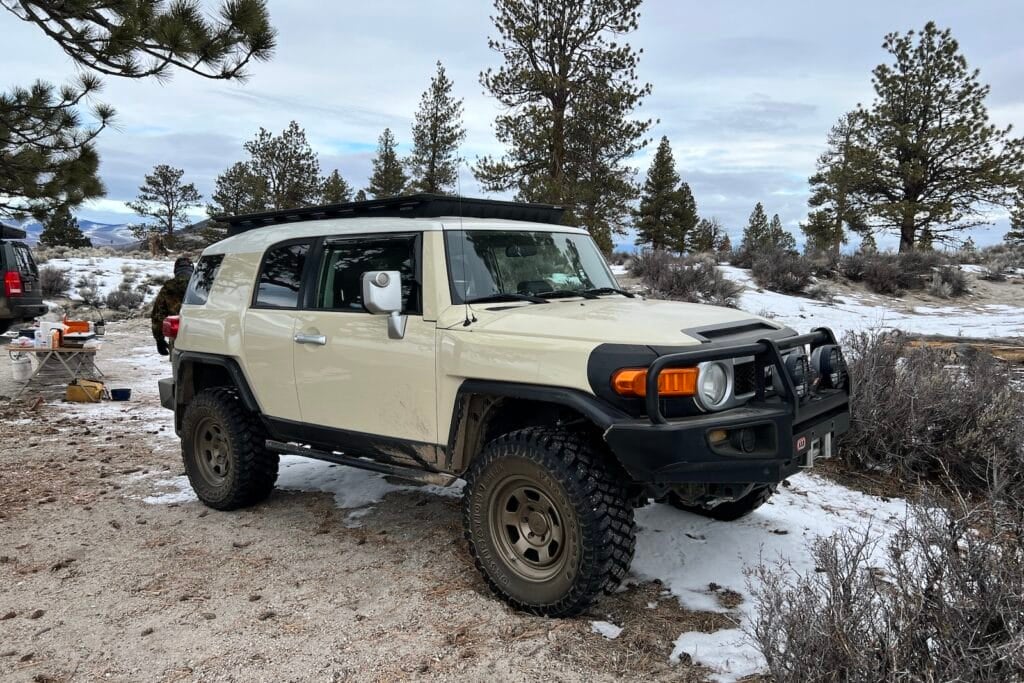
But the bigger eastern halves of Oregon and Washington are made up of high desert landscapes where towns are sparse and small, and cattle still roam a vast area that hasn’t changed much since Lewis & Clark walked to the ocean. The United States government owns more than half the land in Oregon, mostly in the east, and much of that space is available for the public to explore, camp and enjoy responsibly.
Any chance to get out and visit the wilderness areas of the Pacific Northwest is worthwhile, especially in winter when you’re likely to have the whole place to yourself. So when the opportunity presented itself, we packed up with some fellow journalists and a caravan of four capable off-road vehicles. Then we headed out for a multi-day overlanding adventure sponsored by Firestone Tires, riding on its newest off-road products.
Destination unknown
Fittingly, Firestone calls its go-anywhere products “Destination” tires. Within that category, we drove on the Destination M/T2 maximum traction off-road and the Destination XT all-terrain tire specifically designed and rated for snow and ice. Together, these two products represent the extreme capability end of the Destination product line.
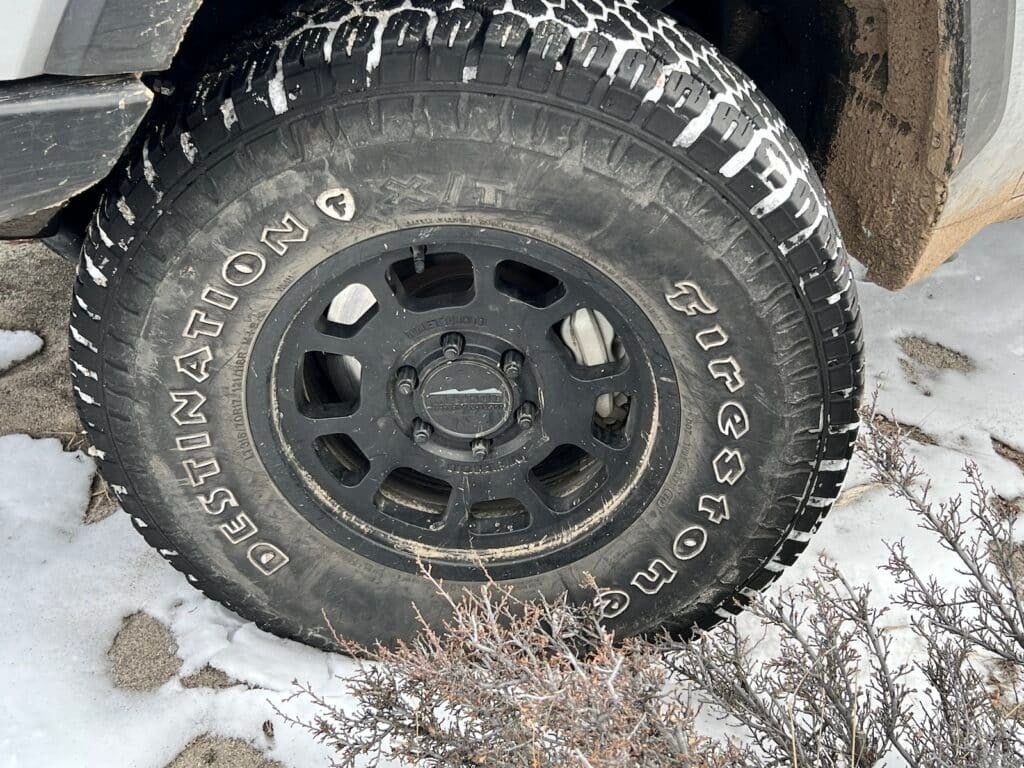
A set of Destination M/T2 tires was fitted to a 2006 Toyota FJ Cruiser, while a set of Destination XT tires was installed on a 2022 Toyota Tundra for our adventure. Both rigs had been extensively modified with off-road suspension and protective plating. More Destination tires outfitted the expedition’s support vehicles, an older Toyota Land Cruiser and a Land Rover LR3.
The Destination M/T2 is a specialty tire made for off-road use. With large tread blocks that extend onto the sides of the tire, this product is made for gripping whatever surface is available. The M/T2 features 3-ply sidewall construction for added protection against flats on the trail. For serious four-wheeling, this is Firestone’s very best.
The Destination XT is somewhat less aggressive off-road, but adds additional focus on winter driving. This tire carries the “three peak mountain and snowflake” symbol that indicates the tire is rated as a winter traction device. However, the Destination XT can be used year-round and for serious off-roading.
Both tires include sipes, which are slices in the tread blocks that are designed to conform around ice and snow, delivering winter traction where a solid tread block would slip. Where we were headed, that proved to be a good thing.
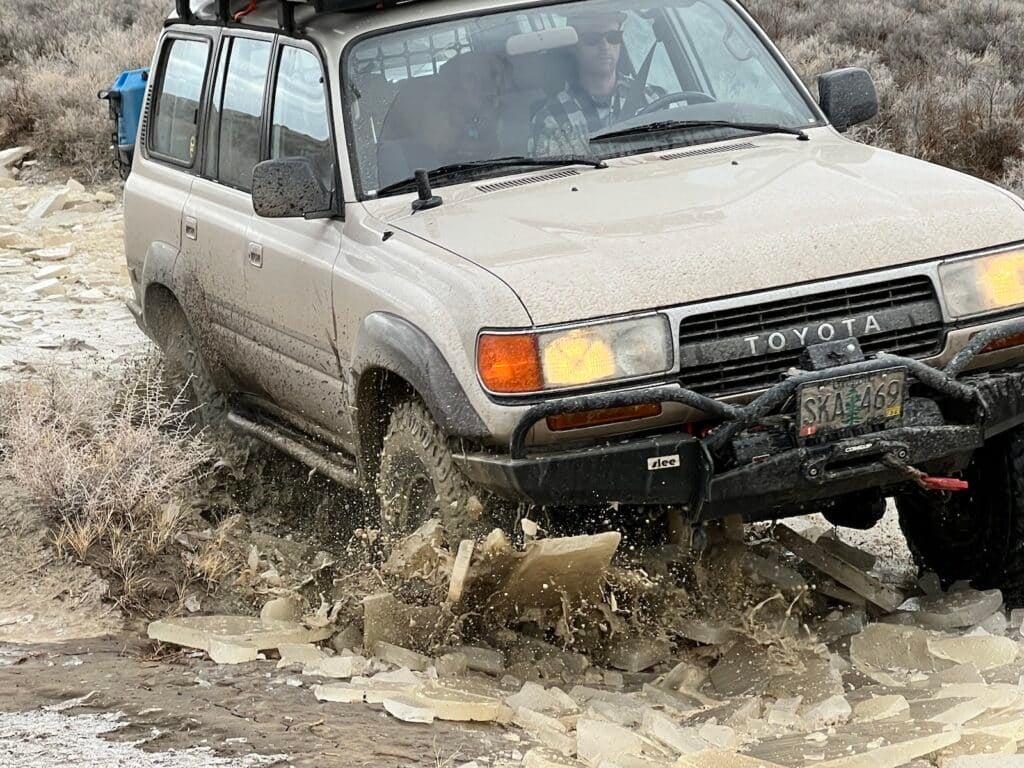
Into the badlands
To get to the wilderness, first you’ve got about a four-hour drive over Interstate freeways and state highways. This was the perfect introduction to the vehicles and the tires. We started in the FJ Cruiser wearing the M/T2 tires, and later drove the Tundra on the XT winter tires.
The big open tread blocks of the M/T2 perform surprisingly well at highway speeds. The off-road tires steer well and don’t wander, even though they certainly generate their share of road noise on the Northwest’s rough pavement. The Destination XT tires on the Tundra are more versatile. With the smaller tread blocks, the XTs delivered a quieter ride on the highway, with precise steering.
When the time came to leave the pavement, we were southeast of Bend, Oregon, near the Oregon Badlands Wilderness area. We set off on the trail, with Pine Mountain Observatory to our right, headed southeast towards Christmas Valley.
When the trail got rough, we reduced air pressure in the tires to 25 psi and shifted to low-range 4WD. The rigs scrambled over the rocks easily, as well as up the increasingly steep hillsides. We made camp on a ridge in the fading light, and got to work building a fire. The temperature drops fast in the desert on a winter night.
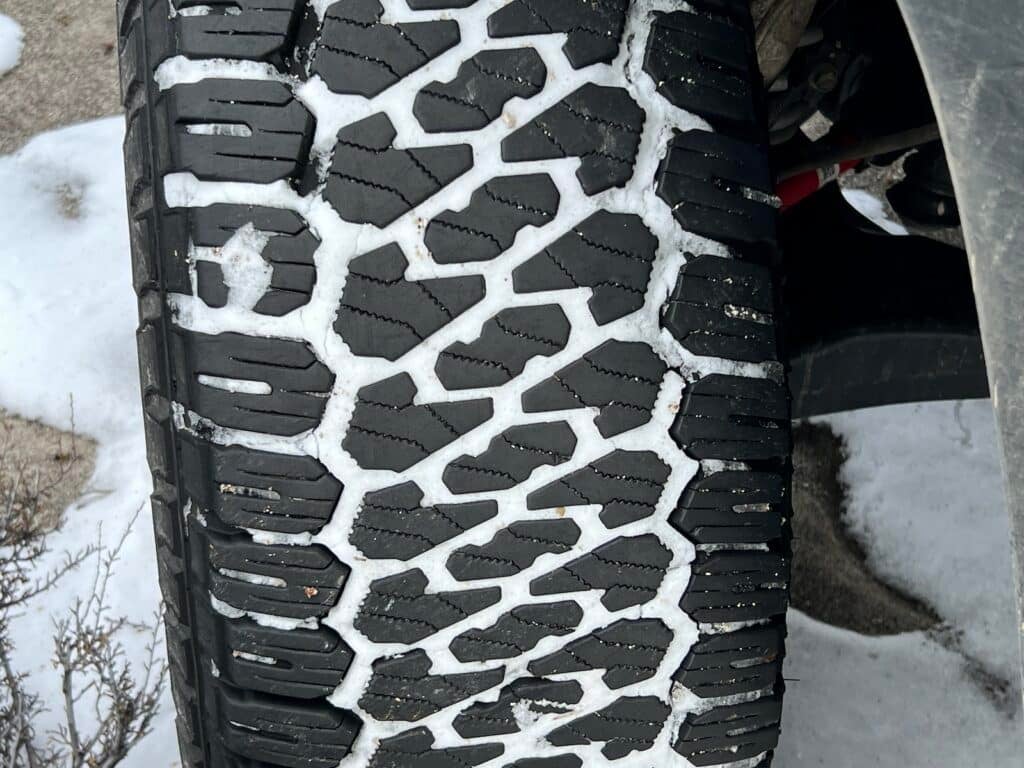
The unforgiving snow
By the morning, clouds rolled over our camp, sprinkling a few desultory snowflakes into our coffee. We packed up our gear and headed in the direction of Summer Lake, into high country where deep snow still clung to the ground.
Snow is an excellent test for any off-road tire, both for the ability to grab hold for traction, and to navigate uneven depths. Snow on the trail is deceptive because it levels itself into a smooth blanket. Dips and depressions are invisible until you drive into them. On our route, every vehicle was often up to its skid plates in the white stuff, struggling to make forward progress.
The Destination M/T2 tires were very good by any standard, but the Destination XT tires were the stars of the show at this point in the trip. Of all four vehicles, only the Tundra riding on the XT snow-and-off-road tires never needed to be pulled through a deep spot. The XT tires used their tread block design with open shoulder blocks at the edges to find that little extra bit of grip needed to maintain forward motion.
Christmas Valley Sand Dunes
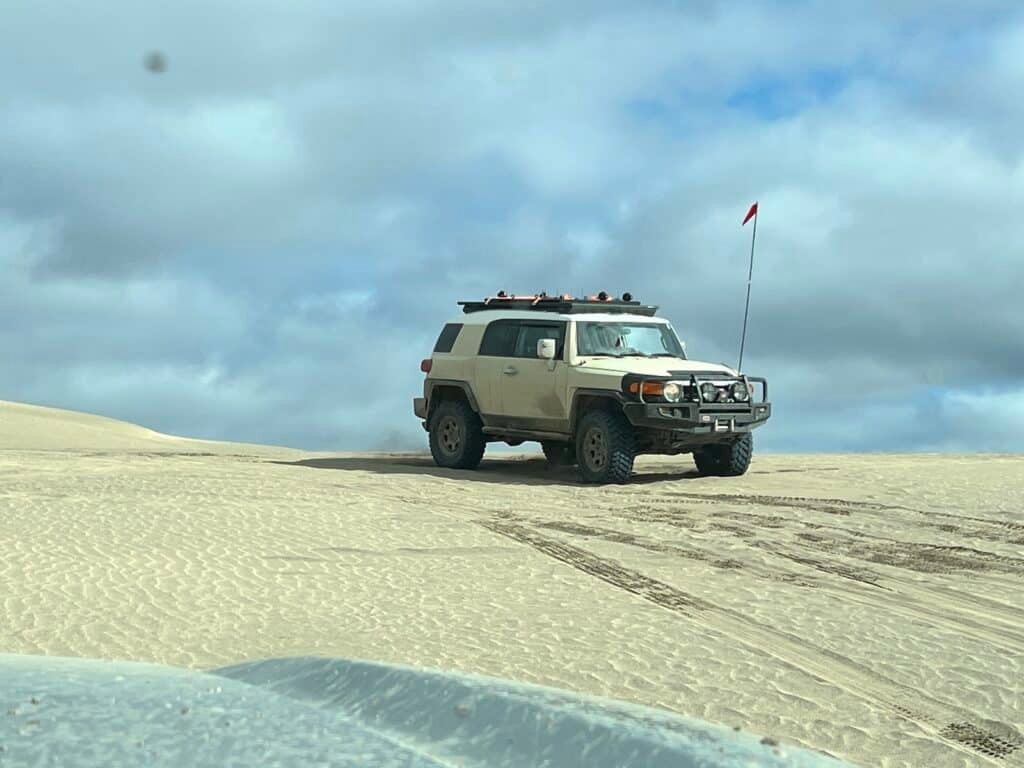
We spent most of the day making steady progress, finally arriving at the Lost Forest Research Natural Area — a small surviving corner of a formerly vast primeval forest of Ponderosa pine trees. Passing through the old growth forest, travelers arrive at the Christmas Valley sand dunes, a patch of several hundred acres of fine sand ground down in ancient lakes and then the winds of the high desert working the pumice and ash deposited by the region’s nearby Mount Mazama (now Crater Lake) and Newberry Crater volcanoes.
The dunes can be hundreds of feet high, and alternately stable or treacherously soft. We traveled in single file to hide our numbers, and then made camp again at the base of the dunes.
For our last morning in the wilderness, we took the air pressure in the tires down further, to 15 psi to help the tires conform to the sand. Every rig was able to climb the tallest dunes without assistance, though sometimes it required more than one attack. The shifting sand poses a special challenge to any tire, and the ability to maintain traction while riding up and over the loose material was aided by the low air pressures. Here the M/T2 off-road tires were back in their element, but the XT winter tires ably got their vehicles to the top of the dunes.
A little ice water
On the trail back to the highway, we ran across an unexpected opportunity for one final test. Low channels in the trail had filled with water and froze in the cold desert air. The ice ranged from thick to thin, which allowed us to observe the tires performing on ice, and in mud. As we expected, the XT tires dominated while the ice held, using their soft rubber compound and sipes to create traction, while the M/T2 tires grabbed the breaking ice and mud in the thinner spots.
As we pumped up the tires by the side of the road, preparing to head back to Portland, we discussed the performance of the vehicles and the tires. We all made it through every terrain, but the varied surfaces showed us the different conditions under which each tire excelled. We were glad to have had both types of tires in our group, which gave us confidence that we would all make it to where the pavement begins again.
- SEO Powered Content & PR Distribution. Get Amplified Today.
- Platoblockchain. Web3 Metaverse Intelligence. Knowledge Amplified. Access Here.
- Source: https://www.thedetroitbureau.com/2023/03/hitting-the-oregon-trail-with-firestone-destination-tires/
- :is
- $UP
- 2022
- a
- ability
- Able
- About
- across
- added
- Additional
- Adds
- Adventure
- against
- aggressive
- AIR
- All
- Ancient
- and
- ARE
- AREA
- areas
- around
- arriving
- AS
- Assistance
- At
- attack
- available
- back
- base
- BE
- because
- BEST
- Big
- bigger
- Bit
- Block
- Blocks
- Breaking
- Building
- by
- Calls
- Camp
- CAN
- capable
- Category
- certainly
- challenge
- Chance
- channels
- Christmas
- climb
- Coffee
- COM
- Compound
- conditions
- confidence
- construction
- Corner
- country
- create
- day
- deep
- delivered
- delivering
- deposited
- Depths
- DESERT
- Design
- designed
- destination
- destinations
- device
- different
- direction
- discussed
- Dont
- down
- drive
- driving
- Drops
- Dune
- each
- easily
- East
- eastern
- element
- enjoy
- especially
- Ether (ETH)
- Even
- Every
- excellent
- expected
- explore
- extend
- extra
- extreme
- FAST
- Features
- Feet
- fellow
- few
- File
- filled
- final
- Finally
- Find
- fine
- Fire
- First
- Focus
- For
- forest
- formerly
- Forward
- fresh
- from
- further
- Gear
- generate
- get
- good
- Government
- grab
- Ground
- Group
- Growth
- Half
- Have
- head
- headed
- Held
- help
- here
- Hide
- High
- Highway
- highways
- hitting
- hold
- However
- HTTPS
- Hundreds
- ICE
- in
- include
- Including
- increasingly
- indicates
- Introduction
- IT
- ITS
- itself
- Journalists
- jpg
- lake
- Land
- land rover
- large
- Last
- Leave
- levels
- Lewis
- light
- likely
- Line
- little
- Low
- made
- maintain
- make
- Making
- material
- max-width
- maximum
- modified
- more
- morning
- most
- motion
- MOUNT
- Mountain
- Natural
- Navigate
- Near
- needed
- Newest
- night
- Noise
- numbers
- observatory
- observe
- ocean
- of
- Old
- on
- ONE
- open
- Opportunity
- Oregon
- owns
- Pacific
- packed
- Passing
- Patch
- Peak
- People
- perfect
- perform
- performance
- performing
- Place
- plato
- Plato Data Intelligence
- PlatoData
- Point
- Portland
- poses
- precise
- preparing
- presented
- pressure
- Product
- Products
- Progress
- protection
- Protective
- proved
- public
- put
- Reduced
- represent
- required
- research
- Ride
- riding
- rig
- road
- Rolled
- Route
- rover
- rubber
- SAND
- seafood
- serious
- set
- several
- Share
- SHIFTING
- show
- Sides
- since
- single
- small
- smaller
- snow
- snowflakes
- So
- Soft
- solid
- some
- somewhat
- Space
- special
- Specialty
- specifically
- speeds
- spent
- Sponsored
- Spot
- stable
- standard
- starbucks
- Stars
- started
- State
- States
- steady
- Still
- Struggling
- summer
- support
- Surface
- suspension
- symbol
- test
- that
- The
- their
- Them
- These
- thing
- Through
- time
- tire
- tires
- to
- together
- top
- towards
- towns
- toyota
- traction
- traveled
- travelers
- Trees
- trip
- types
- under
- Unexpected
- United
- United States
- us
- use
- Valley
- Vast
- vehicle
- Vehicles
- versatile
- Visit
- Volcanoes
- walked
- washington
- Water
- WELL
- which
- while
- white
- winds
- Winter
- with
- within
- without
- Work
- working
- worthwhile
- would
- XT
- yourself
- zephyrnet



